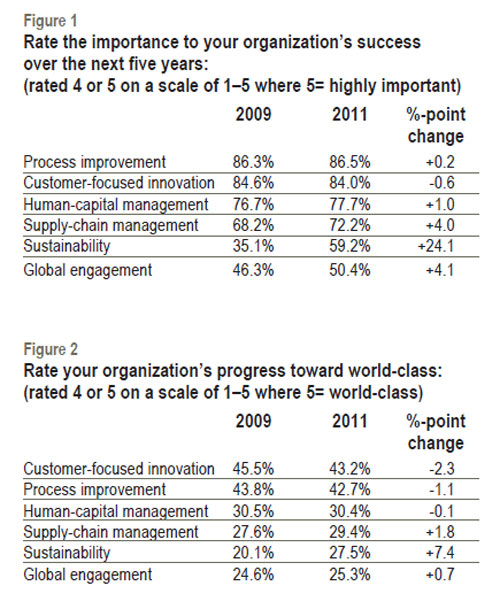From SCDigest's On-Target E-Magazine
Dec. 15, 2011
Supply Chain News: US Manufacturers Must Make Progress in Six Key Areas to Regain Competitiveness
Survey Finds Execution Gap Between Awareness of What Needs to be Done and What is Happening; Few Have Both Lean Talent and Programs
SCDigest Editorial Staff
A recent study by The Manufacturing Performance Institute (MPI) on US manufacturing competitiveness finds that while a growing number of US manufacturers recognize the importance of key capabilities needed to be competitive on a global stage, but that too many companies still exhibit an "execution gap" between what they know needs to be done and what they are actually doing.
SCDigest Says: |
 |
At a high level, the message of the report is that US manufacturers recognize the importance of the six capabilities identified by MPI, but that there is the execution gap mentioned above between understanding and realization.
|
|
What Do You Say?
|
|
|
|
The recent report - titled The Next Generation Manufacturing Study 2011 - identifies six key "next generation" manufacturing strategies. Those strategies/capabilities are:
1. Customer-focused Innovation: Basically, develop new products faster than the competition.
2. Engaged People/Human Capital Acquisition, Development, and Retention: Development of superior systems and processes for talent management.
3. Superior Process Improvement Focus: Drive continuous improvement that exceeds that of the competition, based on company-wide commitment to strategies such as Lean, Six Sigma, etc.
4. Supply Chain Management and Collaboration: Focus on flexibility, response time, and delivery.
5. Sustainability: Finding waste and energy reductions that reduce costs and produce customer value.
6. Global Engagement: Being capable of buying and selling on a global stage.
This seems like a reasonable list of capabilities or focus areas, but we will note that a lack of focus on Sustainability to date has not much hurt Chinese companies that have seen such a huge increase in market share in the last decade, though we agree that energy efficiency will be an increasing component of cost competiveness.
The report is primarily based on survey results from a large number of manufacturers, the second such survey after the first report in 2009. Our sense is that the survey population tilts towards smaller and mid-sized firms, though that would accurately represent US manufacturing demographics. Participants included a very broad cross section of different manufacturing sectors.
The median sales revenues were $12 million for respondent companies, versus an average of $196 million, though as we have learned from our own surveys these numbers have to be considered in how companies respond to such surveys. The results, including reported revenues, are sometimes entered at a full company level, but often at a divisional level and sometimes for just a given plant.
At a high level, the message of the report is that US manufacturers recognize the importance of the six capabilities identified by MPI, but that there is the execution gap mentioned above between understanding and realization, as shown in the graphic below.
Gap Between Recognition and Achievement

Source: The Manufacturing Performance Institute
(Manufacturing article continued below)
|